
The Capitol Limited is a daily Amtrak train between Washington, D.C., and Chicago, running 764 miles (1,230 km) via Pittsburgh and Cleveland. Service began in 1981 and was named after the Baltimore and Ohio Railroad's Capitol Limited which ended in 1971 upon the formation of Amtrak. It carries the Amtrak train numbers 29 and 30, which were previously assigned to the discontinued National Limited.
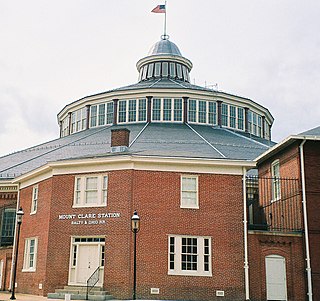
The B&O Railroad Museum is a museum and historic railway station exhibiting historic railroad equipment in Baltimore, Maryland. The Baltimore and Ohio Railroad (B&O) company originally opened the museum on July 4, 1953, with the name of the Baltimore & Ohio Transportation Museum. It has been called one of the most significant collections of railroad treasures in the world and has the largest collection of 19th-century locomotives in the U.S. The museum is located in the Baltimore and Ohio Railroad's old Mount Clare Station and adjacent roundhouse, and retains 40 acres of the B&O's sprawling Mount Clare Shops site, which is where, in 1829, the B&O began America's first railroad and is the oldest railroad manufacturing complex in the United States.

The Budd Rail Diesel Car, RDC, Budd car or Buddliner is a self-propelled diesel multiple unit (DMU) railcar. Between 1949 and 1962, 398 RDCs were built by the Budd Company of Philadelphia, Pennsylvania, United States. The cars were primarily adopted for passenger service in rural areas with low traffic density or in short-haul commuter service, and were less expensive to operate in this context than a traditional diesel locomotive-drawn train with coaches. The cars could be used singly or coupled together in train sets and controlled from the cab of the front unit. The RDC was one of the few DMU trains to achieve commercial success in North America. RDC trains were an early example of self-contained diesel multiple unit trains, an arrangement now in common use by railways all over the world.

The Capitol Limited was an American passenger train run by the Baltimore and Ohio Railroad, originally between New York City and Grand Central Station in Chicago, Illinois, via Union Station, Washington, D.C., Baltimore and Pittsburgh. For almost 48 years, it was the B&O's flagship passenger train, noted for personalized service and innovation. At the time of its discontinuation on May 1, 1971, when Amtrak took over most rail passenger service in the U.S., the Capitol Limited operated between Washington and Chicago.

The Columbian was a named passenger train operated by the Baltimore and Ohio Railroad. It was the all-coach supplemental train of the all-Pullman Capitol Limited. It operated from 1931 to 1964. The train's initial route was between Jersey City, New Jersey and Washington, D.C., but in 1941 the Columbian route was lengthened to Jersey City – Chicago, Illinois. It was the first air-conditioned train in the United States.

The Cincinnatian was a named passenger train operated by the Baltimore and Ohio Railroad (B&O). The B&O inaugurated service on January 19, 1947, with service between Baltimore, Maryland and Cincinnati, Ohio, carrying the number 75 westbound and 76 eastbound, essentially a truncated route of the National Limited which operated between Jersey City, New Jersey and St. Louis.

The National Limited was the premier train of the Baltimore and Ohio Railroad (B&O) on its route between Jersey City, New Jersey and St. Louis, Missouri, with major station stops in Washington, D.C., and Cincinnati, Ohio. It operated from 1925 to 1971. For much of its life it offered exclusive all-Pullman service, and it was the first long-distance train to be entirely air-conditioned. The National Limited was one of many trains discontinued when Amtrak began operations on May 1, 1971. Amtrak revived the name for another New York–St. Louis service which did not use the B&O route.

Camden Station, now also referred to as Camden Street Station, Camden Yards, and formally as the Transportation Center at Camden Yards, is a train station at the intersection of South Howard and West Camden Streets in Baltimore, Maryland, and is adjacent to Oriole Park at Camden Yards. It is served by MARC commuter rail service and local Light Rail trains. Camden Street Station was originally built beginning in 1856, continuing until 1865, by the Baltimore and Ohio Railroad as its main passenger terminal and early offices/ headquarters in Baltimore and is one of the longest continuously-operated terminals in the United States. Its upstairs offices were the workplace of famous Civil War era B&O President John Work Garrett (1820–1884). The station and its environs were also the site of several infamous civil strife actions of the 19th century with the Baltimore riot of 1861, on April 18–19, also known as the Pratt Street Riots and later labor strife in the Great Railroad Strike of 1877.

The Royal Blue was the Baltimore and Ohio Railroad (B&O)'s flagship passenger train between New York City and Washington, D.C., in the United States, beginning in 1890. The Baltimore-based B&O also used the name between 1890 and 1917 for its improved passenger service between New York and Washington, collectively dubbed the Royal Blue Line. Using variants such as the Royal Limited and Royal Special for individual Royal Blue trains, the B&O operated the service in partnership with the Reading Railroad and the Central Railroad of New Jersey. Principal intermediate cities served were Philadelphia, Wilmington, and Baltimore. Later, as Europe reeled from the carnage of World War I and connotations of European royalty fell into disfavor, the B&O discreetly omitted the sobriquet Royal Blue Line from its New York passenger service and the Royal Blue disappeared from B&O timetables. Beginning in 1917, former Royal Blue Line trains were renamed: the Royal Limited, for example, became the National Limited, continuing west from Washington to St. Louis via Cincinnati. During the Depression, the B&O hearkened back to the halcyon pre-World War I era when it launched a re-christened Royal Blue train between New York and Washington in 1935. The B&O finally discontinued all passenger service north of Baltimore on April 26, 1958, including the Royal Blue.
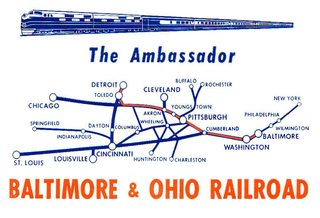
The Ambassador was a named train of the Baltimore and Ohio Railroad (B&O) on its route between Baltimore, Maryland and Detroit, Michigan with major station stops in Washington, D.C. and Pittsburgh, Pennsylvania and Toledo, Ohio. Inaugurated in 1930, the Ambassador was discontinued in 1964.
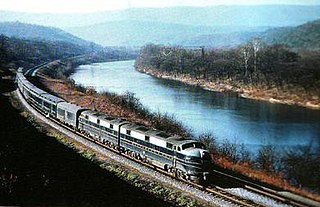
The Shenandoah was an American named passenger train of the Baltimore and Ohio Railroad (B&O), one of four daily B&O trains operating between Jersey City, New Jersey and Grand Central Station in Chicago, Illinois, via Washington, D.C. and Pittsburgh, Pennsylvania from the 1930s to the 1950s. Other B&O trains of that period on the route were the Capitol Limited, Columbian, and the Washington–Chicago Express. An alternate branch originated in Detroit and met with the Chicago part of the train at Deshler, Ohio, south of Toledo.
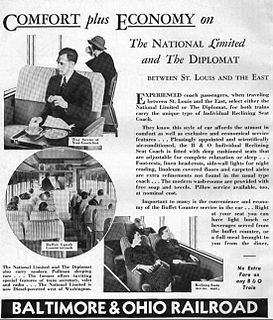
The Diplomat was a named passenger train of the Baltimore and Ohio Railroad (B&O) during the 1930s–1950s connecting New York City and St. Louis, Missouri, via Washington, D.C. Other B&O trains on the route during that period were the premier National Limited and the workhorse Metropolitan Special. The train was inaugurated in August 1930 after several changes to trains along the St. Louis Route. After World War II, the Diplomat operated as Train No. 3 westbound, and No. 4 eastbound. It was timed to provide connections to several western railroads that terminated in St. Louis, including the Frisco, the Santa Fe, Cotton Belt and Missouri Pacific, among others.

The Washington–Chicago Express, an American named passenger train of the Baltimore and Ohio Railroad (B&O), was one of four daily B&O trains operating between Washington, D.C., and Chicago, Illinois, via Pittsburgh, Pennsylvania during the 1930s–1960s. Other B&O trains of that period on the route were the Capitol Limited, Columbian, and the Shenandoah.
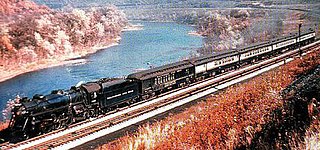
The Washingtonian was one of two daily American named passenger trains operated by the Baltimore and Ohio Railroad (B&O) during the 1940s–1950s between Baltimore, Maryland and Cleveland, Ohio, via Washington, D. C. and Pittsburgh, Pennsylvania. It was the last B&O long-haul passenger train to be powered by a steam locomotive from the venerable railroad's namesake city.

The Marylander was a Baltimore and Ohio Railroad (B&O) afternoon passenger train between New York City and Washington, D.C., operated by the B&O in partnership with the Reading Railroad and the Central Railroad of New Jersey between Jersey City, New Jersey, and Washington, D.C.. Other intermediate cities served were Philadelphia, Wilmington, Delaware, and Baltimore, Maryland. The Marylander's origin can be traced back to the late 1890s, when the B&O began its famed Royal Blue Line service between New York and Washington. Operating as #524 northbound and #525 southbound, the trains were called the New York Express and the Washington Express, respectively, in the 1910s and 1920s. The Marylander and its predecessors offered a high level of passenger amenities, such as parlor cars with private drawing rooms, full dining car service, deluxe lounge cars, and onboard radio and telephone service. The Marylander made history in 1948 when it was the first moving train to offer onboard television reception. It was one of B&O's faster trains on the route, maintaining a four-hour schedule until its discontinuation in October 1956 due to declining patronage.

The Mount Clare Shops is the oldest railroad manufacturing complex in the United States, located in Baltimore, Maryland. It was founded by the Baltimore and Ohio Railroad (B&O) in 1829. Mt. Clare was the site of many inventions and innovations in railroad technology. It is now the site of the B&O Railroad Museum. The museum and Mt. Clare station were designated a National Historic Landmark in 1961.

The Chicago Night Express was an American named train of the Baltimore and Ohio Railroad (B&O) on its route between Wheeling, West Virginia and Chicago, Illinois with major station stops in Newark, Ohio, Mansfield, Ohio and Willard, Ohio. The B&O inaugurated the Chicago Night Express in 1912. It was discontinued in 1956 due to declining passenger demand.

The Pittsburgh & Lake Erie Railroad Station, now Landry's, Inc.'s the Grand Concourse restaurant in Station Square Plaza in Pittsburgh, Pennsylvania, is a building constructed in 1898. Into the 1960s, the station was the depot for the passenger rail operations of the Pittsburgh & Lake Erie Railroad and the Pittsburgh depot from 1934 for the many trains of the Baltimore and Ohio Railroad from Baltimore, Washington, Chicago, Detroit, and St. Louis. In 1934, the B&O obtained trackage rights on the P&LE from New Castle Junction to McKeesport and, until the discontinuance of its passenger service, used the P&LE station to reduce the amount of heavy-curvature trackage required to reach the original B&O station on the opposite side of the Monongahela River.
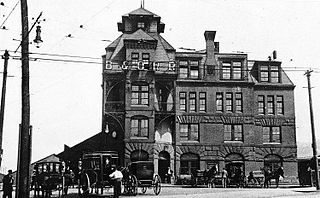
B&O Railroad Depot was one of several railroad stations in the city of Pittsburgh, Pennsylvania during the late 19th and early 20th century. The station was built in 1887, 16 years after the B&O Railroad opened its first railroad line into Pittsburgh. The station was built next to the Monongahela River. B&O railroad trains also used the Pittsburgh & Lake Erie Railroad Station for services that continued westward towards Chicago via the Pittsburgh & Lake Erie Railroad. In 1955 the station was demolished to make room for an interstate highway and remaining services were transferred to Grant Street Station. The building was designed by Frank Furness who also constructed the B&O Railroad's Philadelphia station.





















